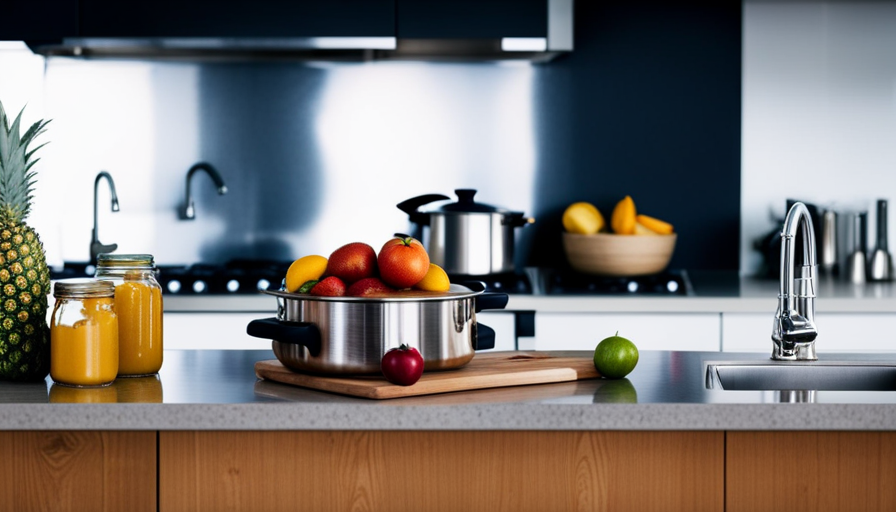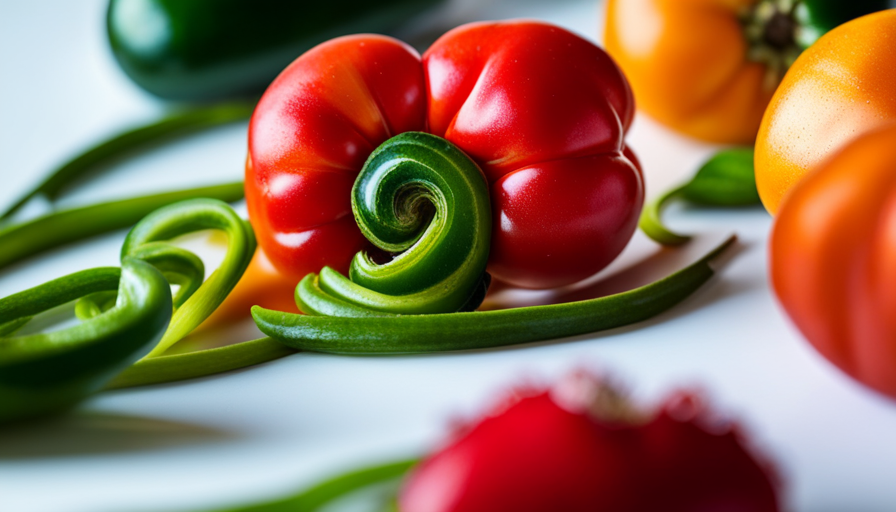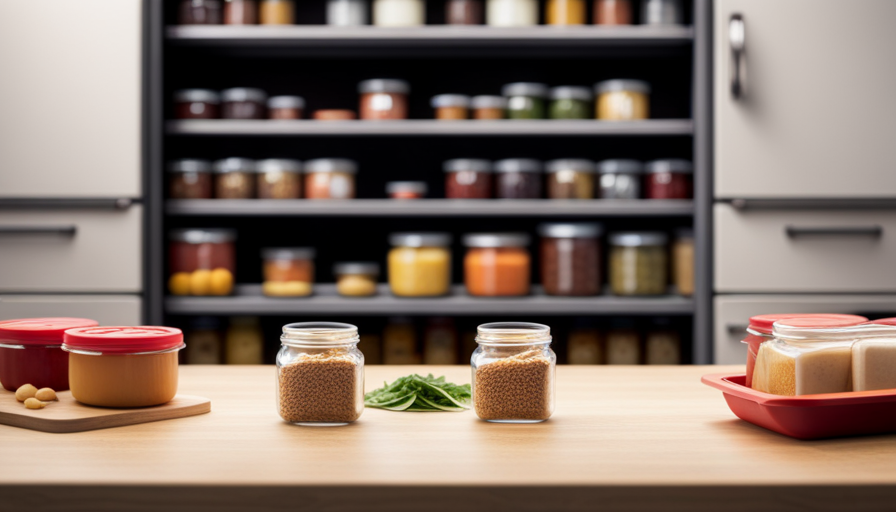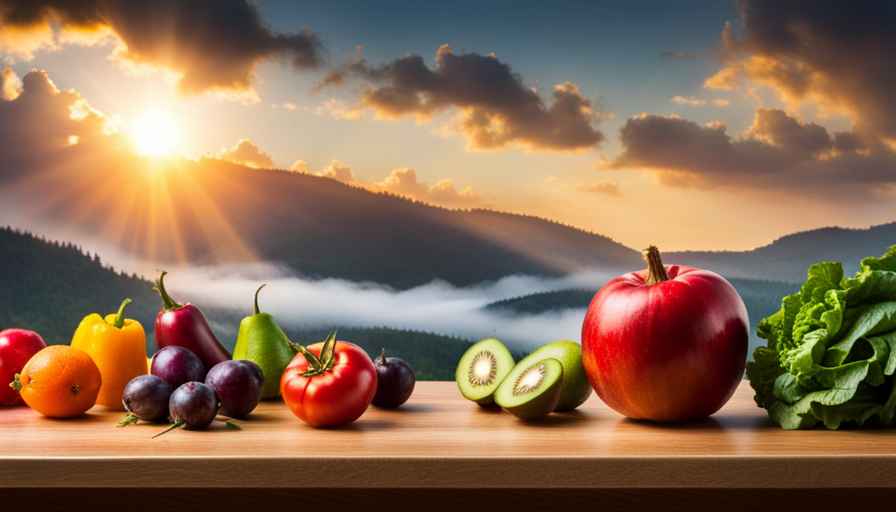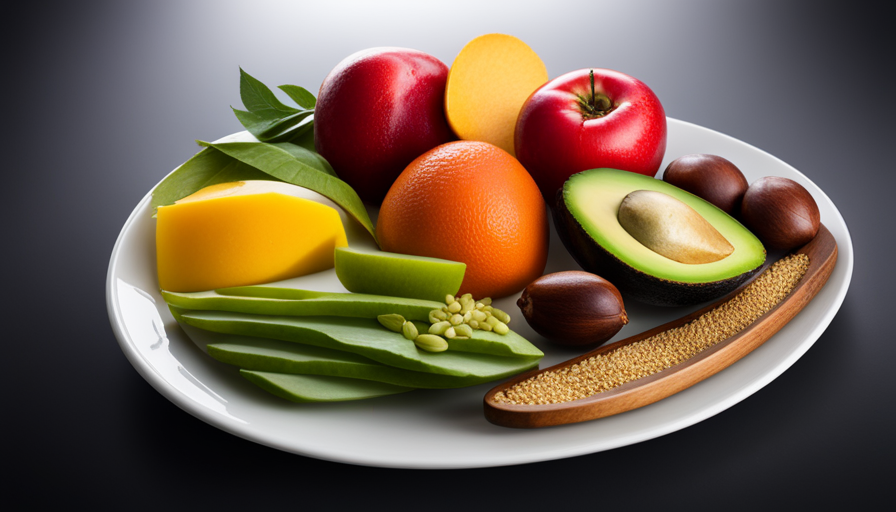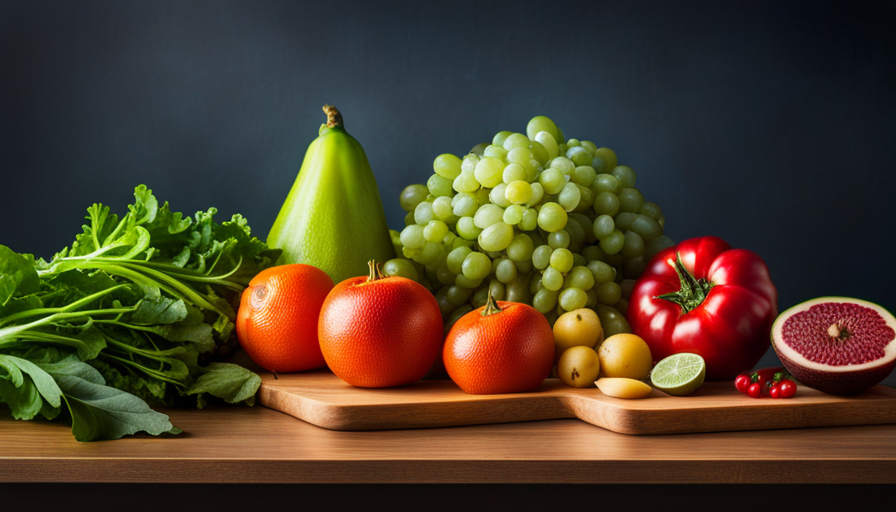Are you ready to embark on an exciting journey towards vibrant health and delicious flavors? Get ready to transform your kitchen into a haven for raw food lovers! Adopting a raw food diet enables you to nourish your body with nutrient-rich, unprocessed foods that are full of life. However, it is important to prepare your kitchen for success before diving into this exhilarating culinary adventure.
Picture this: a kitchen that is both functional and inspiring, stocked with fresh produce, and equipped with the necessary tools to create mouthwatering raw meals. Imagine the satisfaction of effortlessly preparing delicious recipes that will leave you feeling energized and rejuvenated.
In this article, we will guide you through the process of setting up your raw food kitchen. From assessing your kitchen space to stocking up on essential ingredients, organizing your pantry, and investing in quality kitchen tools, we’ve got you covered.
Get ready to create a meal prep system, discover mouthwatering raw food recipes, and learn about food safety and hygiene practices. Plus, we’ll show you how to maintain a clean and functional kitchen space that will inspire your culinary creativity.
So, let’s get started and prepare your raw food kitchen for a journey of health and flavor!
Key Takeaways
- Stock your kitchen with a variety of fresh produce, focusing on fruits, vegetables, nuts, seeds, and sprouts.
- Maximize storage space by adding shelves or cabinets, and utilize vertical space with hooks or racks for pots, pans, and utensils.
- Invest in high-quality kitchen tools and appliances such as a blender, food processor, and dehydrator to make raw food preparation more efficient.
- Plan meals in advance, create a shopping list, and practice food safety and hygiene by storing ingredients properly and washing hands and utensils thoroughly.
Understanding the Raw Food Diet
If you’re ready to embark on a journey towards better health and vitality, understanding the raw food diet is the first step you need to take. Preparing meals in a raw food kitchen involves using uncooked, unprocessed, and organic ingredients to maximize the nutritional benefits.
Raw food enthusiasts believe that cooking destroys important enzymes and nutrients, and that consuming raw foods can boost energy levels, improve digestion, and enhance overall well-being.
In a raw food kitchen, you’ll be focusing on fruits, vegetables, nuts, seeds, and sprouts. These foods are packed with vitamins, minerals, and antioxidants, which can help support a strong immune system and protect against chronic diseases. By avoiding heat, you retain the natural enzymes found in raw foods, which are essential for proper digestion and nutrient absorption.
To get started, stock your kitchen with a variety of fresh produce. Choose organic whenever possible to avoid pesticides and other harmful chemicals. Invest in a high-quality blender, food processor, and dehydrator to help you prepare a wide range of delicious raw meals. Experiment with different recipes and techniques, such as soaking nuts and seeds, sprouting grains and legumes, and marinating vegetables to add flavor and texture.
By understanding the raw food diet and preparing meals in a raw food kitchen, you can unlock the nutritional benefits of uncooked, unprocessed foods and take a step towards a healthier, more vibrant lifestyle.
Assessing Your Kitchen Space
When evaluating your cooking area, take into account the available space and how it can be optimized for a fresh and healthy culinary experience. The layout of your kitchen plays a crucial role in preparing raw food meals efficiently.
Start by assessing the overall layout and functionality of your kitchen. Consider the placement of your appliances, countertops, and storage areas. It’s important to have a well-organized and easily accessible space to make meal preparation a breeze.
Maximizing storage space is key when it comes to setting up a raw food kitchen. Raw food ingredients often require ample space for storing fresh produce, nuts, seeds, and other essentials. Consider adding additional shelves or cabinets to accommodate your growing collection of raw food ingredients. Utilize vertical space by installing hooks or racks to hang pots, pans, and utensils, freeing up valuable counter space.
Another way to optimize your kitchen for raw food preparation is by investing in quality food storage containers. Look for airtight containers that are BPA-free and can keep your ingredients fresh for longer periods. Glass jars and containers are preferable as they are non-toxic and do not leach harmful chemicals into your food.
By evaluating your kitchen layout and maximizing storage space, you can create a functional and efficient raw food kitchen that will inspire and support your healthy lifestyle.
Stocking Up on Essential Ingredients
Maximizing storage space and stocking up on essential ingredients will ensure a well-stocked pantry, allowing for endless culinary creativity and mouthwatering creations.
When it comes to raw food meal ideas, having a variety of ingredients on hand is crucial. Start by stocking up on fresh fruits and vegetables, such as leafy greens, cucumbers, and berries. These can be used as the foundation for delicious salads, smoothies, and wraps. Don’t forget about nuts and seeds, which add a satisfying crunch and a boost of nutrition to any dish. Almonds, walnuts, chia seeds, and flaxseeds are all great options.
In addition to fresh produce, it’s important to have some staple items in your pantry. Raw food storage tips include keeping your nuts and seeds in airtight containers to maintain their freshness and prevent them from going rancid. You’ll also want to have plenty of spices and herbs on hand to add flavor to your dishes. Cumin, turmeric, basil, and cilantro are just a few examples of spices that can take your raw meals to the next level.
By stocking up on these essential ingredients and following raw food storage tips, you’ll have everything you need to create delicious and nutritious raw meals. So get ready to unleash your culinary creativity and enjoy the health benefits of a raw food kitchen!
Organizing Your Pantry and Fridge
Organizing your pantry and fridge will create a sense of calm and efficiency, making it easier to find the ingredients you need for your culinary masterpieces. Maximizing storage is key when it comes to keeping your raw food kitchen well-organized. Utilize every inch of space by using shelves, bins, and baskets to keep similar items together. Consider installing additional shelves or hooks on the doors to make the most of vertical space.
Meal planning is another essential aspect of organizing your pantry and fridge. By planning your meals in advance, you can ensure that you have all the necessary ingredients on hand and avoid last-minute grocery store runs. Create a meal planning chart or use a whiteboard to keep track of your weekly menu. This will not only save you time but also help reduce food waste.
To help you visualize the organization of your pantry and fridge, here is a sample table:
| Pantry | Fridge |
|---|---|
| Nuts and seeds | Fresh produce |
| Grains | Dairy products |
| Spices | Leftovers |
| Oils | Beverages |
| Sweeteners | Condiments |
Remember to regularly clean and declutter your pantry and fridge to maintain a tidy and efficient space. With a well-organized kitchen, you’ll be able to effortlessly prepare your raw food recipes and enjoy the benefits of a healthy and vibrant lifestyle.
Investing in Quality Kitchen Tools
Invest in quality kitchen tools to enhance your culinary experience and make cooking a breeze. Can you imagine effortlessly slicing through your ingredients with a sharp chef’s knife? Investing in durable utensils and choosing sustainable cookware will not only make your raw food kitchen more efficient but also contribute to a more eco-friendly lifestyle.
Here are three essential kitchen tools that you should consider investing in:
-
High-Quality Chef’s Knife: A sharp chef’s knife is a must-have in any kitchen, especially a raw food kitchen where you’ll be working with a variety of fruits and vegetables. Look for a knife made from high-quality stainless steel that’ll retain its sharpness over time. A good chef’s knife will make chopping, dicing, and slicing a breeze.
-
Blender: A powerful blender is essential for creating smoothies, sauces, and dressings in a raw food kitchen. Look for a blender that has a strong motor and durable blades to ensure it can handle blending tough ingredients like nuts and seeds.
-
Dehydrator: A dehydrator is a useful tool for making raw snacks like kale chips, fruit leather, and raw crackers. Look for a dehydrator with adjustable temperature settings and multiple trays to maximize your drying space.
Investing in these quality kitchen tools won’t only make your raw food preparation more efficient but also help you create delicious and nutritious meals with ease. By choosing durable utensils and sustainable cookware, you’ll be on your way to creating a raw food kitchen that’s both practical and eco-friendly.
Choosing the Right Appliances
Creating a culinary sanctuary starts with selecting the perfect appliances that’ll transform your cooking experience. When it comes to choosing the right appliances for your raw food kitchen, there are a few important factors to consider.
First and foremost, think about the size of the appliances you’ll need. Raw food preparation often involves using large quantities of fruits, vegetables, and nuts, so it’s essential to have appliances that can accommodate these ingredients. Look for blenders, food processors, and dehydrators with spacious containers and trays.
Another crucial aspect to consider is energy consumption. As a raw food enthusiast, you’ll likely be using your appliances frequently, so it’s important to choose energy-efficient options. Look for appliances that’re Energy Star certified, as they’re designed to use less electricity without compromising performance. Not only will this help reduce your carbon footprint, but it’ll also save you money on your energy bills in the long run.
Investing in the right appliances for your raw food kitchen can make a world of difference in your cooking experience. With the right size and energy-efficient appliances, you’ll be able to prepare delicious raw meals with ease and peace of mind. So take the time to research and choose appliances that’ll meet your needs and enhance your journey towards a healthier lifestyle.
Creating a Meal Prep System
Having a well-established meal prep system is essential for maximizing efficiency and ensuring a smooth cooking experience in your raw food sanctuary. Meal planning and time management are key factors in creating a seamless workflow.
Here are four tips to help you create a meal prep system that works for you:
-
Plan your meals in advance: Take some time each week to plan your meals and create a shopping list. This won’t only save you time at the grocery store but also ensure that you have all the necessary ingredients on hand when it’s time to cook.
-
Batch cooking: Prepare larger quantities of staple items like grains, beans, and sauces in advance. This will save you time during the week and allow you to quickly assemble meals when you’re pressed for time.
-
Use storage containers: Invest in a variety of storage containers in different sizes. This will make it easier to store and organize prepped ingredients and leftovers, keeping your kitchen tidy and your ingredients fresh.
-
Utilize kitchen tools: Invest in time-saving kitchen tools like a food processor, blender, and mandoline slicer. These tools will make meal prep quicker and more efficient, allowing you to spend less time in the kitchen and more time enjoying your raw food creations.
By implementing these meal planning and time management strategies, you’ll be able to create a well-oiled meal prep system that simplifies your raw food journey and allows you to focus on enjoying delicious and nutritious meals.
Incorporating Raw Food Recipes
To truly elevate your culinary skills and expand your repertoire, consider delving into the world of raw food recipes as you embark on your raw food journey. Raw food meal ideas offer a variety of flavors, textures, and nutrients that can transform your dining experience. Incorporating these recipes into your raw food kitchen will not only add depth and complexity to your meals but also provide numerous health benefits.
A raw food diet consists of unprocessed, uncooked, and mostly organic foods. By consuming fruits, vegetables, nuts, and seeds in their raw form, you can maximize the nutritional value they offer. This way of eating ensures that you obtain essential vitamins, minerals, and enzymes that can be lost during cooking.
To help you get started, here is a table with five raw food meal ideas:
| Breakfast | Lunch | Dinner | Snack | Dessert |
|---|---|---|---|---|
| Green smoothie | Raw veggie wrap | Zucchini pasta | Almond energy balls | Fruit salad |
| Chia pudding | Salad | Nori rolls | Kale chips | Raw cheesecake |
| Overnight oats | Raw sushi | Raw pizza | Carrot sticks | Chocolate mousse |
| Acai bowl | Raw taco salad | Cauliflower rice | Cucumber slices | Coconut bliss balls |
| Berry parfait | Collard wraps | Veggie noodles | Raw granola bar | Avocado chocolate pudding |
Incorporating these raw food meal ideas into your daily routine will not only provide you with a wide range of flavors but also enhance your overall health. Enjoy the benefits of a raw food diet and explore the limitless possibilities it offers.
Practicing Food Safety and Hygiene
Ensure that you maintain a clean and sanitized environment while handling and storing your ingredients to prioritize food safety and hygiene.
When it comes to food storage in a raw food kitchen, it’s important to keep in mind that raw ingredients are more susceptible to contamination than cooked foods. To prevent the growth of harmful bacteria, store your ingredients properly. Keep fruits and vegetables separate from raw meats and seafood to avoid cross-contamination. Use airtight containers or bags to store your ingredients in the refrigerator, and make sure to label them with the date to ensure freshness.
Proper handwashing is also crucial in maintaining food safety and hygiene. Before and after handling any raw ingredients, make sure to wash your hands thoroughly with warm water and soap for at least 20 seconds. This will help remove any dirt, bacteria, or other contaminants that may be present.
Additionally, it’s important to wash any utensils, cutting boards, and countertops that come into contact with raw ingredients. Use hot, soapy water and a scrub brush to thoroughly clean these surfaces, and sanitize them with a mixture of water and bleach.
By following these simple practices, you can ensure that your raw food kitchen is a safe and hygienic environment for preparing delicious and nutritious meals.
Maintaining a Clean and Functional Kitchen Space
Create a clean and functional space by organizing your utensils and equipment in a way that maximizes efficiency while adding a touch of personal flair to your culinary haven. A well-organized kitchen not only makes it easier to find what you need but also promotes a hygienic environment.
Start by creating a cleaning schedule to ensure that your kitchen stays spotless. Designate specific days for deep cleaning tasks such as scrubbing the floors, wiping down countertops, and sanitizing cutting boards. This will help prevent cross-contamination and ensure that your raw food stays safe to consume.
In addition to a cleaning schedule, consider the layout of your kitchen. Arrange your appliances and utensils in a way that allows for easy access and efficient workflow. Keep frequently used items within arm’s reach and store them in designated areas to maintain order. Moreover, make sure to have ample counter space for food prep and avoid cluttering it with unnecessary items.
Don’t forget to add a personal touch to your kitchen space. Hang up a whiteboard or chalkboard to jot down recipes or daily reminders. Display colorful cookbooks or decorative jars filled with spices. These small touches can make your kitchen feel inviting and inspire creativity in your raw food preparation.
By following these tips, you can create a clean and functional kitchen space that’s both practical and aesthetically pleasing.
Frequently Asked Questions
How do I handle food cravings when transitioning to a raw food diet?
Did you know that cravings for certain foods can be triggered by nutrient deficiencies? It’s true! When transitioning to a raw food diet, it’s important to handle these cravings in a healthy way.
Instead of giving in to unhealthy options, try finding raw food substitutes that can satisfy your cravings. For example, if you’re craving something sweet, try indulging in a delicious fruit salad or a raw chocolate avocado pudding. These alternatives can help you stay on track and enjoy your raw food journey.
Can I still enjoy cooked foods occasionally while following a raw food diet?
Yes, you can still enjoy cooked foods occasionally while following a raw food diet. While raw foods offer numerous benefits such as increased nutrient absorption and enzyme intake, incorporating cooked foods can add variety and make the transition easier. Cooked foods provide warmth and comfort, and can be a helpful option when cravings arise. Just be mindful of your choices and opt for healthier cooking methods like steaming or baking instead of frying or deep-frying.
Are there any specific food combinations that I should avoid when preparing raw food meals?
When preparing raw food meals, it’s important to consider food combination ideas to maximize the benefits of a raw food diet. Some combinations to avoid include mixing fruits with vegetables, as they digest at different rates and can cause discomfort.
It’s also recommended to avoid combining starches with proteins, as they require different enzymes for digestion. By being mindful of these food combinations, you can create delicious and nutritious raw food meals that support your health and well-being.
How can I ensure that I am getting all the necessary nutrients on a raw food diet?
To ensure nutrient balance on a raw food diet, there are a few tips for meal planning that you can follow. First, include a variety of fruits, vegetables, nuts, and seeds to get a wide range of nutrients.
Second, make sure to incorporate sources of plant-based proteins like legumes and sprouted grains.
Finally, consider adding supplements like vitamin B12 and omega-3 fatty acids to meet certain nutrient needs.
By following these tips, you can ensure that you’re getting all the necessary nutrients on a raw food diet.
What are some common challenges or obstacles people face when starting a raw food diet, and how can I overcome them?
Overcoming challenges when starting a raw food diet can be tough, but with the right strategies, you can succeed.
One common obstacle is the lack of support from friends and family who may not understand or agree with your decision. To overcome this, find a community of like-minded individuals who can provide encouragement and guidance. Online forums, social media groups, and local raw food meetups are great places to connect with others who share your passion for raw food. Having a support system can make all the difference in staying motivated and sticking to your new lifestyle.
Can I Use a Raw Food Kitchen to Create Gourmet Dishes?
Yes, you can absolutely use a raw food kitchen for making gourmet raw food dishes. With the right ingredients and techniques, you can create delicious and sophisticated gourmet meals without cooking any of the ingredients. Raw food can be just as gourmet and impressive as cooked dishes.
Conclusion
In conclusion, by following the steps outlined in this article, you can successfully prepare a raw food kitchen that’s both practical and efficient.
By understanding the raw food diet and assessing your kitchen space, you can ensure that you have enough room to work with.
Stock up on essential ingredients and organize your pantry and fridge to make it easy to find what you need.
Invest in quality kitchen tools that will help you prepare raw food dishes with ease.
Create a meal prep system that works for you, so you can have meals ready to go when you need them.
Incorporate raw food recipes into your meal plan to add variety and flavor to your meals.
Practice food safety and hygiene to keep your kitchen and food clean and safe to eat.
Maintain a clean and functional kitchen space by regularly cleaning and organizing your kitchen.
By following these steps, you’ll be well equipped to embrace the raw food lifestyle and enjoy the benefits of a raw food kitchen. So go ahead, embark on this nutritious journey and enjoy the benefits of a raw food kitchen!

